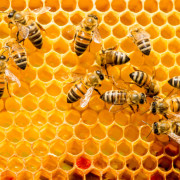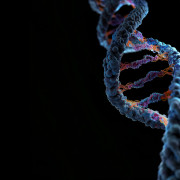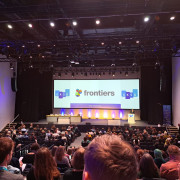- Science News
- Featured news
- How dancing honey bees could help us save pollinators
How dancing honey bees could help us save pollinators
By Suzanna Burgelman/Dr Margaret Couvillon, Virginia Polytechnic Institute and State University

Dr Margaret Couvillon. Image: Margaret Couvillon
Pollinators are under threat worldwide. Researchers such as Dr Margaret Couvillon study bees to find solutions that will benefit the survival of pollinators. Specifically, Couvillon studies the honey bee waggle dance, to discover where and how bees find food. Her research can help design bee conservation and management strategies.
Bees, insects, birds, butterflies, bats. These species have one crucial thing in common: they are pollinators, and our survival depends on them. Around the world, they contribute to the conservation of biodiversity, and importantly, to food security. World Bee Day raises awareness about pollinators and the many threats they face.
As an open access publisher, Frontiers has several research topics focused on pollinator research. Check out this post on our news site for a curated list.
The theme for World Bee Day 2021 is ‘Bee engaged’ – build back better for bees. Today (20 May) is all about highlighting the need for worldwide cooperation to restore and support pollinators and the crucial role they play in biodiversity conservation. Dr Margaret Couvillon, assistant professor of pollinator biology and ecology at Virginia Tech, specializes in honey bee research. She earned her PhD from the University of Sheffield, UK.
Because open access and sharing research is part of Frontiers’ mission, we want to give researchers the voice to express themselves and their research with more creativity and freedom than they otherwise would have in publishing an academic paper.
If you’ve recently published your paper with Frontiers and believe you have a great story to tell, then send an email to press@frontiersin.org with ‘Frontier Scientists’ and your name in the subject line.
What inspired you to become a researcher? Do you have any specific memories that set off a spark?
In 2002, I was an unhappy graduate student in neurobiology without the vocabulary to understand why. I knew I wanted to research animal behavior, but what I didn’t know was that the mechanistic explanations of what generates behaviors, like what we studied as neurobiologists, were not satisfying for me. Although I couldn’t put it to words at the time, I craved an approach that investigated an organism’s behaviors in the field and sought to understand the adaptive value of that behavior.
Towards the end of my first year as a PhD student in neurobiology, I needed to present a seminar, so I spent a lot of time scanning abstracts. That was when I stumbled across a paper by Ben-Shahar et al (2002) describing the effect of gene expression on the age-related transition of worker honey bees from nurses to foragers. The neuro was solid and very cool, but it was the background on honey bee behavioral biology, especially how work is regulated within the hive, that blew my mind. Over the next year, there was an opportunity for me to change fields and directions, so I took it and never looked back.

Image: Hamad Shahsavari/Shutterstock.com
Can you tell us about the research you’re currently working on?
I’m interested in how bees collect their food in the landscape, with a focus on honey bee (Apis mellifera spp) foraging and recruitment. A lot of my work uses the honey bee waggle dance – an amazing behavior unique just to honey bees – as a novel tool for assessing on a landscape scale the availability of forage for honey bees and other pollinators. (See the article published in Frontiers in Ecology and Evolution).
Providing flowers as supplemental forage indiscriminately is a common practice to help hungry bees because current methods of surveying, cataloguing, and comparing floral abundance at a landscape-scale is intensely time-consuming. Additionally, nutritional stress is often studied either in honey bees or non-honey bees. For example, we do not know how Apis forage relates to habitat quality for other bee pollinators.
Our short-term goal is to use dancing honey bees in three distinct environments in Virginia to generate biologically-relevant data on forage availability primarily, but also pesticide exposure. Waggle dances are visible and can be decoded and mapped. This means we can determine both when and where bees are collecting food in a landscape. Importantly, we will then conduct experiments to determine if our results are pertinent to a range of pollinating bees.
In your opinion, why is your research important?
Pollinator declines and especially the role of lack of available and nutritious forage to feed hungry bees is very much in the mind of the public, and people really want to help. But before aid can be directed in a meaningful and targeted way, we need to understand better how bees are collecting their food in the existing landscape.
That’s where my research comes in. We hope to contribute to best management strategies to improve pollinator nutrition by generating data on when and where supplemental forage is most needed. More broadly, we want to know if honey bees can act as bioindicators to inform on a landscape’s ability to feed other pollinators.
‘Before aid can be directed in a meaningful and targeted way, we need to understand better how bees are collecting their food in the existing landscape’
Dr Margaret Couvillon
Are there any common misconceptions about this area of research? How would you address them?
Our work often uses the honey bee waggle dance, which tells the location of where a honey bee has collected its food. I often get asked how we know that’s what the bee is saying.
We know because the waggle dance was first understood by Karl von Frisch, the Austrian ethologist who later shared a Nobel Prize in Physiology for this discovery.
Secondly, we know because, similar to von Frisch, we can do calibration experiments. In these experiments, we train honey bees that are individually marked with a little number tag to collect sugar syrup from an artificial feeder at a known location. The sugar syrup is extremely sweet and rewarding, so these bees are likely to go back to their hive and do a waggle dance to tell their nestmates about it.
We use special glass-walled observation hives, which means we can see the dance of the marked bee. We do this with many bees in different locations, which then allows us to work out the translation of the dance into a distance and direction.

Glass-walled bee hive. Image: Zyabich/Shutterstock.com
What are some of the areas of research you’d like to see tackled in the years ahead?
There’s so many applied questions that we need to address to help the health and well being of our pollinators, but I also have an interest in understanding better when bees miscommunicate with each other.
How has open science benefited the reach and impact of your research?
Anyone that works with pollinators, especially honey bees, is part of a large community of stakeholders that intimately depend upon the science that comes from our research. Many of these stakeholders do not have regular access to a research institution’s journal subscriptions, making open science crucial in the dissemination of information.
If you have recently published your research with Frontiers and believe you have a story to tell, then you might feature as part of our new Frontier Scientists series! Send an email with the subject line ‘Frontier Scientists’ and your name to press@frontiersin.org , as well as details on what your most recent research was about.







